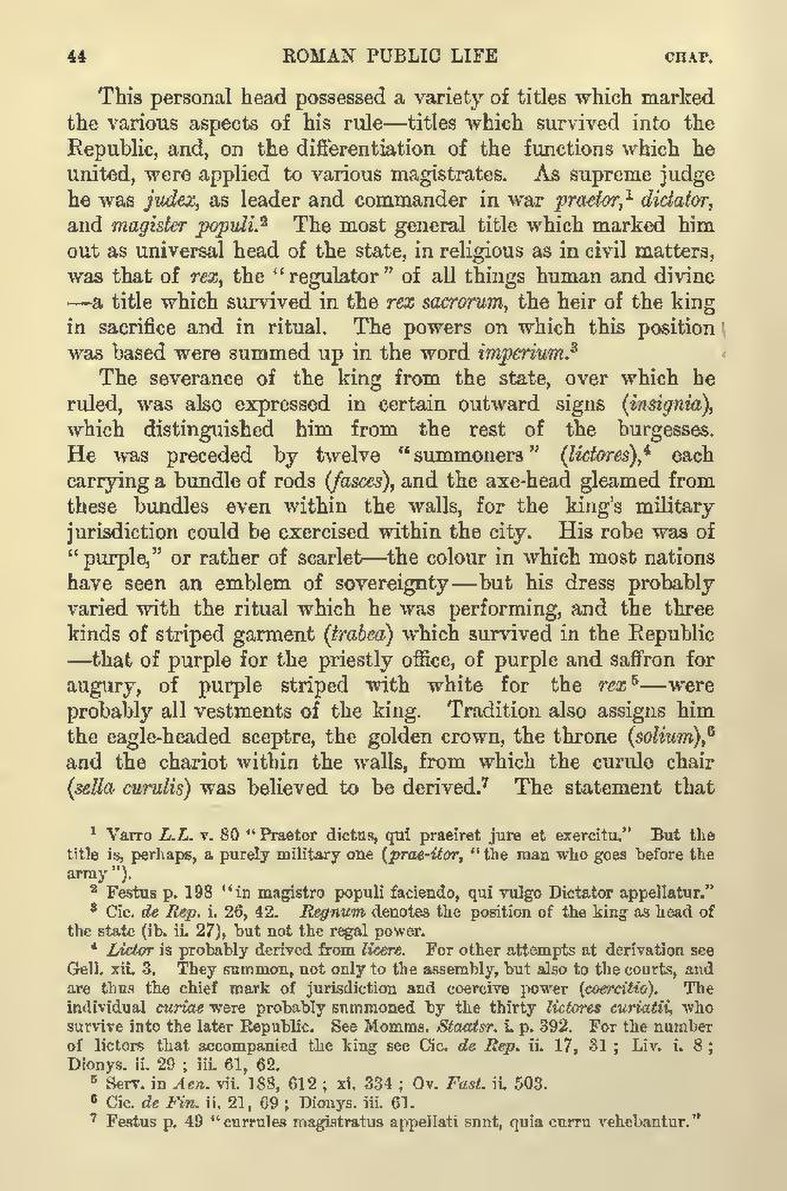This personal head possessed a variety of titles which marked the various aspects of his rule—titles which survived into the Republic, and, on the differentiation of the functions which he united, were applied to various magistrates. As supreme judge he was judex, as leader and commander in war praetor,[1] dictator, and magister populi.[2] The most general title which marked him out as universal head of the state, in religious as in civil matters, was that of rex, the "regulator" of all things human and divine—a title which survived in the rex sacrorum, the heir of the king in sacrifice and in ritual. The powers on which this position was based were summed up in the word imperium.[3]
The severance of the king from the state, over which he ruled, was also expressed in certain outward signs (insignia), which distinguished him from the rest of the burgesses. He was preceded by twelve "summoners" (lictores),[4] each carrying a bundle of rods (fasces), and the axe-head gleamed from these bundles even within the walls, for the king's military jurisdiction could be exercised within the city. His robe was of "purple," or rather of scarlet—the colour in which most nations have seen an emblem of sovereignty—but his dress probably varied with the ritual which he was performing, and the three kinds of striped garment (trabea) which survived in the Republic—that of purple for the priestly office, of purple and saffron for augury, of purple striped with white for the rex[5]—were probably all vestments of the king. Tradition also assigns him the eagle-headed sceptre, the golden crown, the throne (solium),[6] and the chariot within the walls, from which the curule chair (sella curulis) was believed to be derived.[7] The statement that
- ↑ Varro L.L. v. 80 "Praetor dictus, qui praeiret jure et exercitu." But the title is, perhaps, a purely military one (prae-itor, "the man who goes before the army").
- ↑ Festus p. 198 "in magistro populi faciendo, qui vulgo Dictator appellatur."
- ↑ Cic. de Rep. i. 26, 42. Regnum denotes the position of the king as head of the state (ib. ii. 27), but not the regal power.
- ↑ Lictor is probably derived from licere. For other attempts at derivation see Gell. xii. 8. They summon, not only to the assembly, but also to the courts, and are thus the chief mark of jurisdiction and coercive power (coercitio). The individual curiae were probably summoned by the thirty lictores curiatii, who survive into the later Republic. See Momms. Staatsr. i. p. 392. For the number of lictors that accompanied the king see Cic. de Rep. ii. 17, 31; Liv. i. 8; Dionys. ii. 29; iii. 61, 62.
- ↑ Serv. in Aen. vii. 188, 612; xi. 334; Ov. Fast. ii. 503.
- ↑ Cic. de Fin. ii. 21, 69; Dionys. iii. 61.
- ↑ Festus p. 49 "currules magistrates appellati sunt, quia curru vehebantur."
